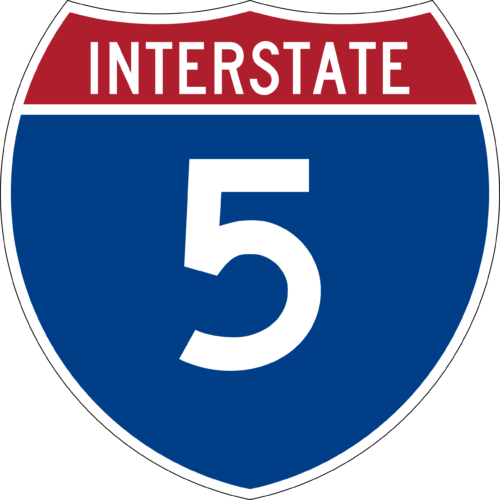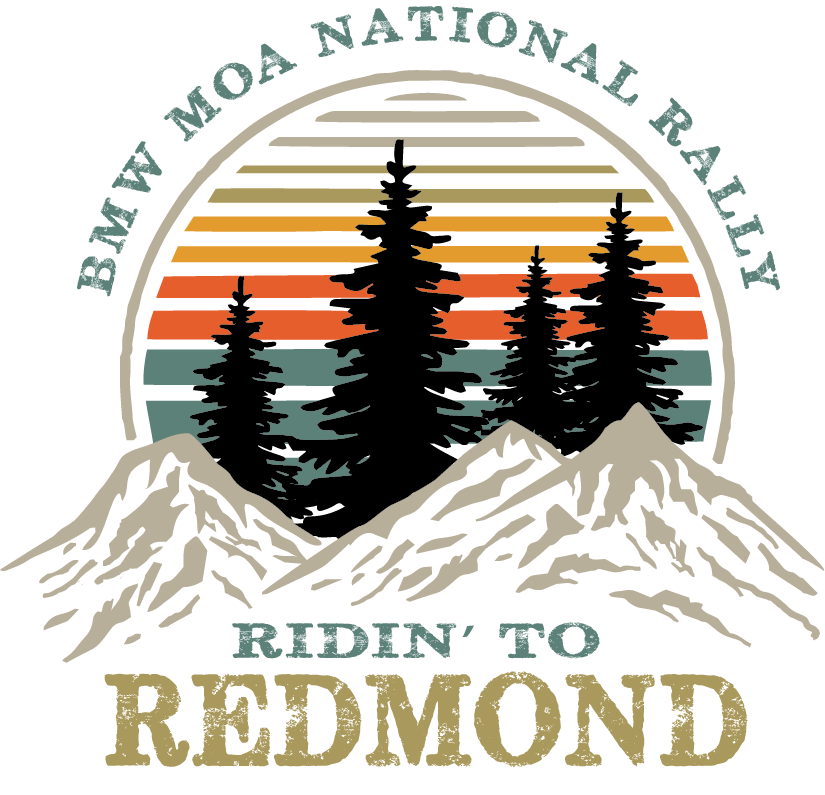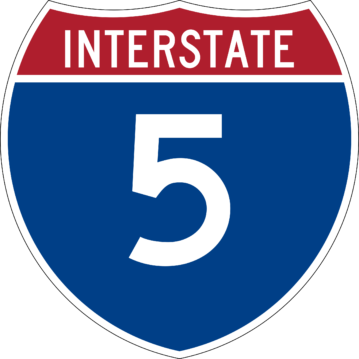
Did you know that I-5 is the only continuous Interstate highway to touch both the Mexican and Canadian borders? The northward journey begins at the Mexican border crossing in San Ysidro, California and terminates 1,381 miles north at the Canadian border near Blaine, Washington. Congested through the LA basin, it tops Tejon Pass to run the length of California’s Central Valley before ascending again to the Oregon border and beyond. Redding to the Oregon border is fabulous, the valley section, not so much. Most travelers north to the rally will exit on to US-97 at Weed, California to make the final 221-mile run to Redmond.
But there are many routes that parallel I-5 in California. And a few that merit staying on I-5 a little or a lot longer into Oregon. And we can’t forget our Washington and British Columbia brethren who may be scooting south on I-5. For all of you, we also offer sublime alternatives to the Interstate.
From California?
Pinnacles NP Bypass
(147 miles; 75 miles if you stay on I-5)
Take exit 334 toward Coalinga on CA-198. Rolling hills mark the ascent into California’s Coast Range. This is earthquake country; you’ll pass by a junction to Parkfield, the self-proclaimed “Earthquake Capital of the World.” Turn north on CA-25 toward Hollister. Rolling hills and sweeping curves dominate this two-lane road. At the 80-mile mark lies Pinnacles National Park, noteworthy for its eroded remains of an extinct volcano. Food and fuel can be found in Hollister at the 110-mile mark. CA-152 eastbound completes the loop.
Sutter Buttes/Sacramento National Wildlife Refuge Bypass
(106 miles; 17 miles if you stay on I-5)
The Central Valley of California extends approximately 450 miles along the I-5 corridor. At the northern end, a unique mountain cluster appears to the east, a large pock-mark on the otherwise flat valley floor. These are the Sutter Buttes, a circular complex of eroded lava domes just west of Yuba City. They have a colorful history dating back to indigenous times. In the early 60s, the Air Force built a missile launch complex in the north Buttes and in 2016, a reconnaissance aircraft crashed there.
Rather than looping directly back to I-5 at Colusa, it’s fun to ride north along the Sacramento River to the crossing near Butte City. This will take you through the heart of the Sacramento NWR, which supports over 250 bird species. Early morning is the best time of day for this particular side trip.
Hayfork/Callahan Bypass
(203 miles; 86 miles if you stay on I-5)
I suggested at the top that Redding to the Oregon border is the most scenic stretch of I-5. But I suspect that many California riders already know that. What they may not know is that CA-36 and CA-3 are two of the most rugged and twisty highways in northern California. From the south, take I-5 exit 650 and head into Red Bluff. CA-36 winds its way into the coast range. The road is excellent and so are the curves. At the 65-mile mark head north on CA-3. North of Hayfork, the curves ratchet up a notch. Gas up in Weaverville; there are no more services until I-5. The road remains excellent but it narrows and steepens as it climbs Scott Mountain, before plummeting toward Callahan on the north side. At Callahan, the climb begins anew before descending into the Shasta Valley with Mt. Shasta in the distance. A truly spectacular bypass.
If you stay on I-5 north of Redding…
Two noteworthy natural landmarks won’t disappoint. Lake Shasta Caverns is a two-mile ride east of I-5 at exit 695. Plan on at least two hours as you catamaran across the McCloud Arm of Shasta Lake to catch a bus that steeply climbs to the cave entrance. The caves consist of several enormous rooms connected by a byzantine network of ladders. Flowstone, stalactites, stalagmites are highlighted along the tour. Even though it’s just off the beaten path, the tour is a commitment, but well worth the effort. Be forewarned: the stairs and ladders are a workout. Hope you’re in good shape.
Twenty-five miles north, the massive granite Castle Crags will catch your eye above the trees to the left of I-5. The road to Vista Point, a steep, barely single-lane meander may even trump the view at the top. There, a trail takes you to a viewpoint where the crags and Mt. Shasta to the east, dominate the horizon. It’s a great place for a picnic if you pack a lunch. Or, you can stop for a burger and a shake at Sten’s Burger Strand eight miles up the road in Dunsmuir.
On into Oregon… OR-253/OR-66 to Klamath Falls
(97 miles; 68 miles if you exit I-5 at Weed)
You’ve bypassed Weed and continued into Oregon, looking for adventure. You won’t look long. Exit 1 onto OR-253 is a twisty rollercoaster that traces the original route over the Siskiyou Mountains that mark the Oregon-California border. It quickly drops into the Rogue River Valley, where it tees into OR-66. But not before twisting into a short pig-tail at the bottom.
OR-66 heads east and the first third of this section is the real reason you made the detour. The climb from the valley floor to the top of the Cascade-Siskiyou National Monument is a superbly engineered motorcycle marvel. From the valley floor, OR-66 climbs 4,500 feet in less than ten miles. To celebrate, stop for ice cream at the Green Springs Inn before motoring on to Klamath Falls and US-97. Note that gas is sparse between I-5 and Klamath Falls. Topping off in Hornbrook may not be a bad idea if you’re less than half a tank.
Crater Lake
(207 miles to OR-138/US-97 junction; 132 miles if you exit I-5 at Weed)
To get to Crater Lake, leave I-5 at exit 30 in Medford. Need a bite on your way to see the lake? You can’t do much better than Beckie’s Café, just across Union Creek along OR-62. Leave room for a piece of Becki’s pie, made fresh daily.
Crater Lake is Oregon’s only national park. It was formed when Mt. Mazama, a 12,000-foot peak, imploded around 7,700 years ago. The result is an azure jewel sitting 6,200 feet above sea level that is the deepest lake in the United States. Winter snow may still ring the rim of the caldera; the lake lies 200 feet below the rim. If possible, take the Rim Drive around the lake as you make your way northward. The stark descent north of the lake will quickly return you to US-97.
From Washington or British Columbia?
The Clackamas River Highway
(190 miles to Redmond; 207 miles via I-84/US-197; 156 miles via Government Camp)
You may be thinking, I-5 to Portland; I-84 to The Dalles; OR-197 south. Or perhaps you’ll take US-26 through Government Camp. Either will work, but little of these routes is truly memorable (except for the Columbia River Gorge or Mt. Hood, of course). Plus, I’m sure serious riders in the region have traversed both numerous times.
Another option that is guaranteed to bring you back is to trace the Clackamas River along the southwest shoulder of Mt. Hood. Skirting the greater Portland area, you’ll be amazed how quickly urban civilization gives way to wilderness. To get there, leave I-5 at exit 7 for I-205. Continue south into Oregon exit 16/OR-224. Stay on OR-224 past Estacada. Here the canyon beckons and civilization fades away. The region south was devastated by wildfires in 2020 and this section of the canyon exhibits plenty of evidence. But the scars fade away and the road narrows to two narrow lanes. At Ripplebrook, OR-turns to NF-46 until it terminates in Detroit, 50 miles south. Turn left (east on to OR-22 and follow the signs to Redmond.
Any and all of these routes will add to the delight a rally sojourn provides. But camaraderie is just ahead. Congratulations … at long last you’ve arrived in Redmond!
You can find a GPS file for this route in the BMW MOA's Ride with GPS organization account here: https://ridewithgps.com/routes/46172677
USING RIDE WITH GPS
![]() Ride with GPS is a great way for the MOA to share and distribute maps, GPS routes and turn-by-turn instructions. As with any great service, some best practices in the form of tips and tricks are in order.
Ride with GPS is a great way for the MOA to share and distribute maps, GPS routes and turn-by-turn instructions. As with any great service, some best practices in the form of tips and tricks are in order.
- Each route in Ride with GPS is equivalent to a track in the world of Garmin GPS units and BaseCamp software. So for all the routes, make sure you get the entire collection of routes in Ride with GPS.
- Ride with GPS allows you to download many different GPS files types, including GPX, for the BMW Navigator series and other Garmin productsWhen downloading GPX files, only download the "GPX Track" version.
- The "GPX Route" version will leave you at the mercy of the settings on your Garmin GPS, and will take you off the planned route and maybe to unexpected places and road conditions.
- Once you have the "GPX Track" version loaded on your device and want turn-by-turn navigation, convert the "track" on your Garmin GPS to a "trip."
- If you don’t have a dedicated GPS device and use your phone for navigation, Ride with GPS also has a number of file formats to work with various navigation apps for phones.
- Ride with GPS also has its own phone app that will also help guide you! Download now for Apple iOS or Android.


